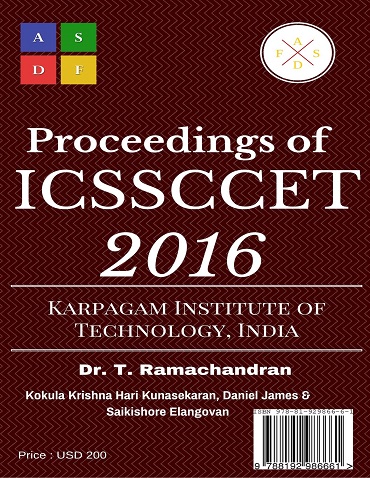- Publication Meta:Value
- Short Title:ICSSCCET 2016
- Publisher:ASDF, India
- ISBN 13:978-81-929866-6-1
- ISBN 10:81-929866-6-7
- Language:English
- Type:Hard Bound - Printed Book
- Copyrights:ICSSCCET Organizers / DCRC, London, UK
- Editor-in-Chief:Dr T Ramachandran
- Conference Dates:18 - 19, March 2016
- Venue Country:Coimbatore, India
- Submitted Papers:825
- Acceptance Rate:8.12%
- Website:www.icssccet.org
Welcome to ASDF Electronic Digital Library!
ICSSCCET 2016
ICSSCCET 2016
International Conference on Systems, Science, Control, Communication, Engineering and Technology 2016
Paper 151
Study the Flow Analysis of Hypersonic Vehicle Combustion
Vadivel S1, Melvin Jone A2, K Madhan Muthu Ganesh3
1,2,3Karpagam Institute of Technology, Coimbatore, Tamilnadu, India.
Abstract
In recent trends, most implausible development was supersonic combustion chamber which operated without any moving parts. Due to the deceleration of the free stream air, the pressure, temperature and density of the flow entering the burner are "considerably higher than in the free stream". At flight Mach numbers of around Mach 6, these increases make it inefficient to continue to slow the flow to subsonic speeds. Thus, if the flow is no longer slowed to subsonic speeds, but rather only slowed to acceptable supersonic speeds, the ramjet is then termed a 'supersonic combustion ramjet,' resulting in the acronym scramjet. In this work the hot flow entering are altered to hypersonic speed, resulting in hypersonic combustion. This condition may be obtained by changing the swirler's into required geometrical shape. Factors such as size, weight, design complexity, maintainability, longevity, storability, production and life cycle costs, and logistic supportability were identified to be just as important as the performance characteristics (speed, range, and efficiency) of the hypersonic vehicle. These are analyzed using computational fluid dynamics software. The results were simulated for different boundary condition with varying blades at hypersonic speed level and then results will be compared to get positive and negative feedback.
Keywords
Author's Profile
Author profile can be generated and linked through our partners World Book of Researchers. To include your profile online Click Here. After it is approved, please email to edlib @ asdf.res.in to create a link with all the papers.
e-AID
ICSSCCET.2016.151
Cite this Article as Follows
Vadivel S, Melvin Jone A, K Madhan Muthu Ganesh. "Study the Flow Analysis of Hypersonic Vehicle Combustion" International Conference on Systems, Science, Control, Communication, Engineering and Technology (2016): 735-738. Print.
© 2010 - by EDLIB .
All Rights Reserved.

